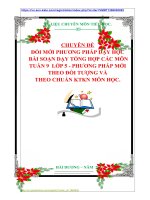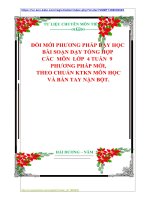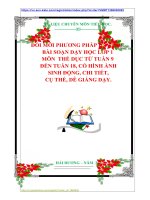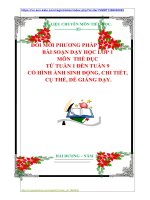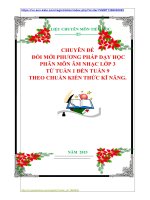Ta7 tuan 9 p25,26,27
Bạn đang xem bản rút gọn của tài liệu. Xem và tải ngay bản đầy đủ của tài liệu tại đây (239.3 KB, 23 trang )
<span class="text_page_counter">Trang 1</span><div class="page_container" data-page="1">
Date of planning: October 30<small>th</small>, 2022 <b>Week: 09</b>
<b>UNIT 4: MUSIC AND ARTS</b>
<b>Lesson 1: Getting started – A talk at the school gate (Period 25)I. OBJECTIVES</b>
By the end of this lesson, students will be able to:
<b>1. Knowledge</b>
<i>- Have an overview about the topic Music and arts- Use the vocabulary to talk about Music and arts</i>
<b>2. Core competence</b>
- Develop communication skills and creativity
- Be collaborative and supportive in pair work and team work - Actively join in class activities
<b>3. Personal qualities</b>
- Develop self-study skills
<b>II. MATERIALS </b>
- Grade 7 textbook, Unit 4, Getting Started - Computer connected to the Internet. - Projector/ TV/ pictures and cards
/ˈklæsɪkəl/ traditional in style or form, or based on methods developed over a long period of time, and considered to be of lasting
an object, such as a piano, guitar, or drum, that is played to produce musical sounds
nhạc cụ
4. landscape (n)
/ˈlændskeɪp/ a large area of countryside, especially in relation to its appearance
cảnh quan
</div><span class="text_page_counter">Trang 2</span><div class="page_container" data-page="2">5. art gallery (n)
/ˈɑːt ˌɡæləri/ a building where works of art can be seen by the public, are shown and can
In each activity, each step will be represented as following: * Deliver the task
** Implement the task *** Discuss
**** Give comments or feedback
* Teacher plays a piece of music and lets students listen to.
v=rotCiRkaE08&ab_channel=Dmusix ** Students listen to music.
*** After that, teacher asks students some questions about it and calls some students to give their ideas.
<i>- Do you like the piece of music you have listened?/ - Do you know what kind of music it is?/ - When do you listen to music?/ - How do you feel when you listento music?/ - Is music important to our life?</i>
**** Teacher comments on their ideas and then leads students to the new topic in
Teacher says: “As you can see, music and arts play an important role in our life. It can help people relax, entertain, or enrich
T-Ss 5 mins
</div><span class="text_page_counter">Trang 3</span><div class="page_container" data-page="3">their mind. Therefore, in Unit 4 we are
<i>going to learn more about them Music and Arts.”</i>
<b>SET THE SCENE: PRE- QUESTIONS</b>
* Teacher draws students’ attention to the pictures in the textbook and asks them some questions about the pictures. Teacher don’t confirm whether their answers are right or wrong.
1. Who are they?
2. What are they doing?
3. What are you going to learn in this lesson today?
<i><b>Suggested answers:</b></i>
1. They are Trang and Nick / students. 2. Nick is playing the piano and Trang is
**** Teacher asks them to read and listen to the conversation to check their answers.
* Teacher introduces the vocabulary by: + showing the pictures illustrating the
</div><span class="text_page_counter">Trang 4</span><div class="page_container" data-page="4">) 1. classical (a): [antonym]
2. spare time (n): [synonym / explanation] 3. musical instruments (n): [visual]
4. landscape (n): [explanation] 5. art gallery (n): [visual] ** Students say the words.
*** Other students correct if the previous answers are incorrect.
**** Teacher shows and says the words aloud and asks students to repeat them.
<i><b>LISTEN AND READ. (Ex. 1, p. 40)</b></i>
* Teacher plays the recording, asks
students to underline the words related to
<i>the topic Music and arts. </i>
- Teacher can play the recording more than once.
- Students listen and read.
** Teacher can invite some pairs of students to read aloud.
*** Teacher refers to the questions previously asked.
**** Then, teacher confirms the correct
<i>answer: “Trang and Nick are going to tellus about their hobbies, especially about music and arts.</i>
* Teacher asks students to answer without reading the conversation again.
** Ss work out and answer questions in
</div><span class="text_page_counter">Trang 5</span><div class="page_container" data-page="5">To help students understand more the text; to acquaint students with the grammar points and music and arts.
*** Teacher asks some students to explain why they did not choose the other two options.
**** Teacher confirms the correct answer.
<i><b>Answer key: C</b></i>
<b>TASK 2: COMPLETE EACH OF THESENTENCES WITH A SUITABLE WORD OR PHRASE FROM THE </b>
<i><b>BOX. (Ex 3, p. 41)</b></i>
* Teacher asks students to work independently to read the sentence, identify the kind of information to fill in the blanks, read the text again to locate the place to find the word.
** Students work individually, then they can share their answers with their partners before discussing as a class.
*** Teacher calls some students to check. **** Teacher confirms the right answers and writes on the board.
<i><b>Answer key:</b></i>
1. art gallery 2. Photos 3. different from 4. like 5. musical instruments
<b>TASK 3: WRITE THE CORRECT WORD OR PHRASE UNDER EACH </b>
<i><b>PICTURE. (Ex 4, p. 41)</b></i>
* Teacher asks students to work in pairs to do the task.
** Students work in pairs.
*** Teacher plays the recording for students to check and repeat.
</div><span class="text_page_counter">Trang 6</span><div class="page_container" data-page="6">To help students revise the
vocabulary related
<i>to the topic Music and arts and to </i>
evaluate how artistic they are.
**** Teacher checks and corrects their pronunciation and gives students the meaning of the words if needed.
<i><b>Answer key:</b></i>
1. paintbrush 2. camera 3. painting 4. musical instruments
5. water puppet show 6. art gallery
<i><b>TASK 4: QUIZ HOW ARTISTIC ARE </b></i>
<i><b>YOU? (Ex 5, p. 41)</b></i>
* Teacher asks students to work
individually to answer all the questions and add up their points.
** Students work individually to do the task.
*** Students report to their groups how artistic they are. Then, teacher calls on some students to report to the whole class. **** Teacher gives some comments. what students have learnt in the lesson.
- Ask one or two students to tell the class what they have learnt.
- Ask students to say aloud some words they remember from the lesson. If there is an overhead projector in the
classroom, show the dialogue and highlight the key words related to the
- Prepare the vocabulary for the next lesson: A closer look 1.
- Project preparation
+ Teacher informs student of the final project of the Unit’s project.
T-Ss 1 min
</div><span class="text_page_counter">Trang 7</span><div class="page_container" data-page="7">+ Explain the requirements of the project: Imagine that you are going to organise a music show and then design an invitation for that show. Students will show their posters and present their ideas in Lesson 7 – Looking back and Project.
+ Teacher explains to students how they can get the information.
+ Put students into groups and ask them to discuss to assign tasks for each member. Help them set a deadline for each task. (Teacher should check the progress of students’ preparation after each lesson.)
<i>Chuyên mônBGH ký duyệt ngày …. tháng 11 năm 2022</i>
<b>P. Hiệu Trưởng</b>
<b>Nguyễn Thị Ngọc</b>
Date of planning: October 30<small>th</small>, 2022 <b>Week: 09</b>
<b> UNIT 4: MUSIC AND ARTSLesson 2: A closer look 1 (Period 27)I. OBJECTIVES</b>
By the end of this lesson, students will be able to:
<b>1. Knowledge </b>
- Vocabulary:
<i>+ use the lexical items related to the topic Music and arts;</i>
+ pronunciation: pronounce and recognize the sounds /ʃ/ and /ʒ/.
</div><span class="text_page_counter">Trang 8</span><div class="page_container" data-page="8"><b>2. Core competence</b>
- Develop communication skills
- Be collaborative and supportive in pair work and teamwork - Actively join in class activities
<b>3. Personal qualities</b>
- Be ready to know the words about music and arts - Develop self-study skills
<b>II. MATERIALS </b>
- Grade 7 textbook, Unit 4, A closer look 1 - Computer connected to the internet
- TV/ Projector/ Pictures/ Cards
2. actress (n) /ˈæktrəs/ a woman who pretends to be
someone else while performing in a film, play, or television programme
nữ diễn viên
3. artist (n) /ˈɑːtɪst/ someone who paints, draws, or makes sculptures
nghệ sĩ
4. composer /kəmˈpəʊzə(r)/ a person who writes music nhà soạn nhạc 5. puppet (n) /ˈpʌpɪt/ a toy in the shape of a person or
animal that you can move with strings or by putting your hand inside
con rối
6. portrait (n)
/ˈpɔːtrət/ a painting, photograph, drawing, etc. of a person or, less commonly, of a
</div><span class="text_page_counter">Trang 9</span><div class="page_container" data-page="9">In each activity, each step will be represented as following: * Deliver the task
** Implement the task *** Discuss
**** Give comments or feedback
* Teacher divides students into 2 groups and has them listen to some songs to guess what kinds of music they are.
** Students work in 2 groups, try to listen, and guess.
*** The member in each group which has the answer can raise hand. If student has the correct answer, he/ she will get 1 point for his/ her group. **** Teacher confirms the winner.
</div><span class="text_page_counter">Trang 10</span><div class="page_container" data-page="10">Teacher leads students into the lesson by telling them that “In today lesson, we are going to learn more words to
<i>talk about Music and arts and two </i>
* Teacher introduces the vocabulary by: + providing the synonyms or antonyms
of the words;
+ providing the pictures of the words. - Teacher has students read the phrases
aloud and corrects their pronunciation if needed.
- Teacher asks students for the Vietnamese meanings of these phrases.
1. concert hall: [visual + explanation] 2. actress (n): [visual + explanation]
</div><span class="text_page_counter">Trang 11</span><div class="page_container" data-page="11">3. artist (n): [visual + explanation] 4. composer (n): [visual + explanation] 5. puppet (n): [visual + explanation] 6. portrait (n): [visual + explanation] 7. photography (n): [visual +
8. perform (v): [visual + explanation] ** Students say the words.
*** Other students correct if the previous answers are incorrect.
**** Teacher shows and says the words aloud and asks students to repeat them.
<i><b> Checking techniques: </b></i>
“Rub out and remember”
<b>TASK 1: LISTEN AND REPEAT THESE WORDS AND PHRASES, THEN WRITE THEM IN THE </b>
<i><b>CORRECT COLUMNS. (Ex. 1, p. </b></i>
* Teacher asks students to listen and repeat the words independently. ** Students work individually.
*** Teacher calls on some students to read aloud the words.
**** Teacher corrects their
pronunciation and explains the meaning of these words/ phrases if needed. * After that, teacher asks students work in pairs to put these words / phrases in the correct box.
** Students work in pairs.
</div><span class="text_page_counter">Trang 12</span><div class="page_container" data-page="12">To revise / teach the names of some people and places related to the topic.
To teach students how to combine a verb and a noun to
*** Some students read out their
<b>TASK 2: MATCH A WORD IN A WITH A WORD OR PHRASE IN B.</b>
<i>(Ex 2, p. 42)</i>
* Teacher asks students to work in pairs to do the task and explains to students that in English some verbs and nouns go together, and some don’t.
** Students work in pairs to do matching to form collocations.
*** Some students give their answers. **** Teacher checks students ‘answers
* Teacher has students work individually to read the sentences carefully and look for clues to complete
</div><span class="text_page_counter">Trang 13</span><div class="page_container" data-page="13">talk about music
*Teacher writes on the board two words
<i><b>musician and television. Then, teacher </b></i>
has students focus on the sounds of the two underlined letters “c” and “s”. ** Students practice saying the word individually.
*** Teacher calls some students to read aloud.
**** Teacher corrects if needed.
* After that, teacher says “In this lesson we are going to learn how to pronounce two sounds /ʃ/ and /ʒ/”.
**Teacher asks students to watch Tiếng Anh 7 - Pronunciation video, Unit 4
<i>(link youtube)</i>
*** Students imitate and practise the two sounds together.
**** Teacher explains if needed.
</div><span class="text_page_counter">Trang 14</span><div class="page_container" data-page="14">***Teacher asks students to listen and try to repeat the words as a class, a group, and individually.
**** Teacher may play the recording as many times as necessary and correct their pronunciation.
<b>TASK 5: LISTEN AND REPEAT, AND SINGLE-UNDERLINE THE WORDS WITH THE SOUND /ʃ/ AND DOUBLE-UNDERLINE THEWORDS WITH THE SOUND /Ʒ/. </b>
<i>(Ex 5, p. 42)</i>
* Teacher has students read the sentences and tells them to pay
attention to the words with sounds /ʃ/ and /ʒ/ to underline.
** Students read and underline words with the two sounds they have learnt. *** Teacher plays the recording for students to listen and repeat each sentence. Teacher calls on some students to read the sentences
</div><span class="text_page_counter">Trang 15</span><div class="page_container" data-page="15"><b>GAME: SIMON SAYS</b>
* Teacher prepares some words which include the two sounds students have learnt.
- Teacher gives students the rules of the game:
+ If teacher says only one word all students must sit still. The person who stands up will be the loser.
+ If teacher says, “Simons says …….” all students must listen carefully to identify which sound mentioned in each word.
/ʃ/: students stand up. /ʒ/: students sit still.
+ At the end of the game: the group which has more students with correct answers will be the winner.
** Students listen to the rules of the game and can discuss with other members in their groups.
*** Students play in groups.
**** Teacher informs which group is
</div><span class="text_page_counter">Trang 16</span><div class="page_container" data-page="16"><i>shy, vision, sugar, machine, closure, dishwasher, occasion, leisure, rubbish, </i>
Teacher asks students to talk about what they have learnt in the lesson.
T-Ss 1 min
HOME WORK
To revise what they have learnt.
Find 5 more words with the sound /ʃ/ and 5 more words with the sound /ʒ/. Write them down and practice
pronouncing the words.
T-Ss 1 min
</div><span class="text_page_counter">Trang 17</span><div class="page_container" data-page="17">Date of planning: October 30<small>th</small>, 2022 <b>Week: 09</b>
<b>UNIT 4: MUSIC AND ARTSLesson 3: A closer look 2 (Period 27)</b>
1. like to show that sth is similar to sth else.
This picture is like the one I saw at the art museum.
2. different from to show that two or more things are not similar.
Painting portraits is different from
to show that sth is “more” or “less” than sth else.
Classical music is not as exciting as rock.
<b>2. Core competence</b>
- Develop communication skills
- Be collaborative and supportive in pair work and team work - Actively join in class activities
<b>3. Personal qualities</b>
- Be responsible and hard-working
<b>II. MATERIALS </b>
- Grade 7 textbook, Unit 4, A closer look 2 - Computer connected to the Internet - TV/ Projector/Pictures, sets of word cards - sachmem.vn
<b>III. PROCEDURES</b>
<i><b>Notes : </b></i>
In each activity, each step will be represented as following: * Deliver the task
** Implement the task
</div><span class="text_page_counter">Trang 18</span><div class="page_container" data-page="18">*** Discuss
**** Give comments or feedback
* Teacher asks students to work in 2 teams to think of as many adjectives to describe as possible.
** Students work in 2 teams.
*** In 1 minute, students from each team, turn by turn, run to the board and write down one adjective.
**** Teacher comments and counts how many correct answers for each team.
- The team which has more correct answers will be the winner.
<i><b>Suggested answers:</b></i>
big, small, heavy, light, cheap,
expensive, boring, interesting, special, fun, thin, fat, tall, short, handsome, ugly, etc.
* Teacher shows the picture and asks students to use one adjective they have found to make comparisons.
** Students work individually. *** Students give teacher a sentence: “The boy on the left is taller than the boy on the right.”
**** Teacher gives feedback, then lead to the new lesson.
</div><span class="text_page_counter">Trang 19</span><div class="page_container" data-page="19">Teacher says: “This lesson today is going to tell you more about
<i>comparisons using like, different from,</i>
* Teacher prepares some pictures and asks students to make comparisons. ** Students make comparison, using the pictures teacher shows on the screen.
Elicit the model sentences:
<i>1. Teacher points to the yellow pencil and the orange pencil. </i>
Students: The yellow pencil is shorter than the orange one.
Teacher: Right! Or I can say: “The yellow pencil is not as long as the orange one.”
<i>2. Teacher points to the yellow pencil and the pen and asks students to focus on the length of the two things.</i>
The pen is as long as the yellow pencil.
<i>3. Teacher points to the yellow pencil and the pen again and has students focus on their shape.</i>
The pen is different from the yellow pencil.
<i>4. Teacher says: “This is Robert’s pencil case and this is Mary’s pencil case” and asks them make comparison</i>
T-Ss Ss-Ss
9 mins
</div>